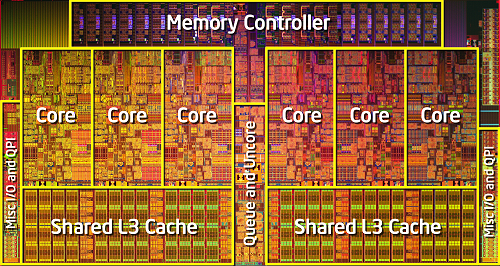Intel Core i7 980XE in detail
The Core i7 980X Extreme Edition is similar in a number of ways to Intel's former Core i7 flagship processor, the 975 Extreme Edition. Both processors operate at a 3.33GHz frequency, feature a 6.4GT/s QPI link, utilize triple-channel DDR3 memory, support the LGA1366 socket, and have a thermal design power of 130 watts.

Despite all this the Core i7 980 is a very different animal. For one, it is based on the 32nm die shrink of Nehalem known as Gulftown – which itself is part of the Westmare family that also includes Clarkdale and Arrandale. Therefore whereas all current 45nm Bloomfield Core i7 processors feature 4 cores with 8 threads (Hyper-Threading), the Core i7 980 can pack 6 cores into a similar package and feature an incredible 12 threads.
The two extra cores come alongside an increase from 8MB to a more substantial 12MB of shared L3 cache. The L2 cache remains at just 256KB per core, so with 6 cores that totals 1536KB.

The extra cores and cache also means that the Core i7 980X now boasts a monolithic transistor count of 1.17 billion. As crazy as that sounds, the die size is just 240mm2, which actually makes it physically smaller than processors based on the Bloomfield and Lynnfield architectures thanks to its 32nm design. In fact, the die size is even smaller than that of an AMD Phenom II X4 at 258mm2.
Like previous Core i7 processors, the Core i7 980X supports Turbo Boost technology, which allows it to take the stock speed of 3.33GHz up to 3.60GHz when just two or less cores are active. With more than two cores running the chip can still operate at 3.46GHz, making it one of the fastest Core i7 processors released to date.

Something worth noting is that according to its specifications the Core i7 980X Extreme is only officially designed to work with DDR3-1066 memory, whereas all other Core i7 processors use DDR3-1333 memory. That said, we had no problem running memory at 1333MHz or even well beyond this when overclocking our chip.